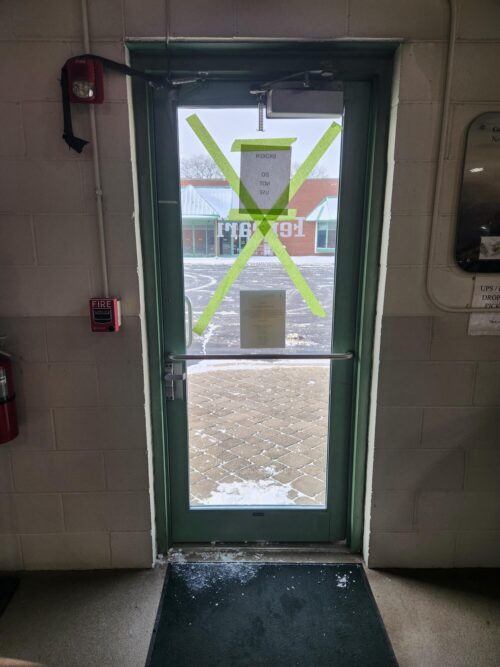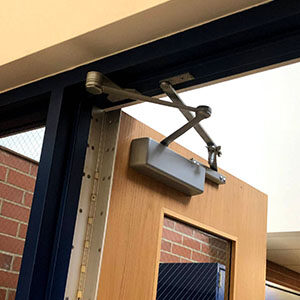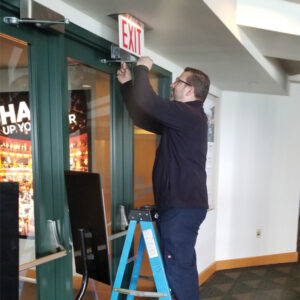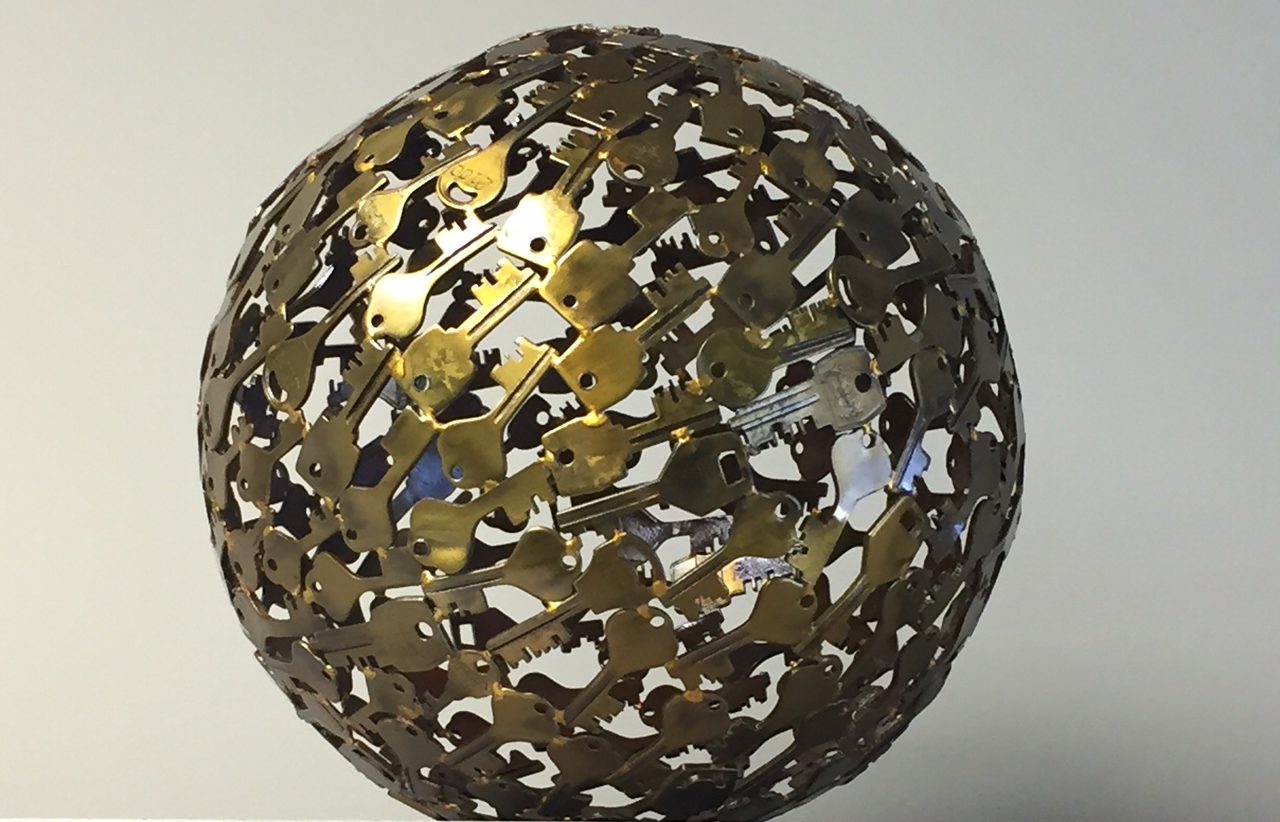 This phrase lets a visitor know they are no longer welcome, and should leave.
This phrase lets a visitor know they are no longer welcome, and should leave.
But it could also be a warning that the door closer is broken, and if you are not careful, the door just might hit you on your way out!
Windy weather causes frequent, uncontrolled, and dangerous slamming doors. Stormy gusts are capable of snapping a door closer arm. Severe wind can also lead to misaligned hinges, shattered glass, and warped doors and frames. Repeated slamming, over time, can force the door from the opening, causing the seam where trim meets jamb to separate, leaving an exterior gap where moisture and cold air can infiltrate. An excellent added measure of protection against high winds is an overhead stop.
Changes in air pressure can also cause a door to slam. As air moves from an area of higher pressure (indoors), perhaps caused by an open window, to an area of lower pressure (outdoors), the change can cause enough air movement to slam a door.
The sudden slam of a door is startling. Repeated slamming is insufferable! The solution? A new door closer. Closers are important for controlling an opening, not only for functionality but also for security, safety, and accessibility. There are innumerable brands, types, sizes, and finishes from which to choose.

Wind-damaged door with Do Not Use sign posted until Anderson Lock could replace the door closer.
To determine the correct door closer, you need to know:
- the door size.
- the door location within the building.
- and the location of the closer on the door.
- whether mounted visibly on the surface of the door, concealed inside the upper frame (header), or above the door.
Anderson Lock stocks door closers for every application, retrofit, and new construction. We partner with all the top-name manufacturers to provide the industry’s best technology, dependability, and functionality while matching your building’s needs and aesthetics. Maintenance professionals rely on our inventory for replacement door closer arms, actuators, drop plates, and spacers. Building owners rely on our expert installation services.
Here are some of the key factors affecting door closer selection:
- Weight and width of the door:
- Doors vary in weight from a light hollow core wood door to a heavy metal door. Door sizes given in tables are based on doors of standard weight and height. Compensation must be made for extra-heavy doors and doors of unusual width.
- Draft and wind conditions:
- Draft and wind conditions are perhaps the most important factors to consider in determining door closer size. Sizes listed in tables apply to normal conditions. Stairwells, air conditioning, building construction, and location of door can result in strong draft and wind conditions, requiring a larger size closer than listed.
- Location of closer on the door:
- Regular Arm – The closer is mounted on the pull side or the door. The arm is attached to door frame face. Generally used on interior doors.
- Top Jamb – The closer is mounted on the frame face above the door on the push side of the door. The arm is attached to the top of the door (top rail). Generally used on doors with narrow top rail, i.e. aluminum and glass “storefront” doors.
- Parallel Arm – The closer is mounted on the push side of the door. The arm is attached to a special Parallel Arm Bracket that is then mounted to bottom of frame stop. Arm is “parallel” to the door, therefore able to endure mischievous abuse as in schools. Generally used where aesthetics are important and for locations where ceilings are flush with the doorway.

Heavy-duty door closer, with extra duty arm, and an overhead stop
The way a door closer is mounted affects its operation. Anderson Lock stocks many closers that can be mounted all three ways. This universal mounting capability is noted where it applies.
In addition to the three ways a door closer is mounted, there are several options for arms on LCN’s 4000 Series:
- EDA – Extra Duty Arm
- HDB – Universal Hold Open
- CUSH – Parallel Arm Hold Open
- SCUSH – Parallel Spring Hold Open
- DEL – Delayed Action (Delayed action closers provide a delay period from when the door is opened to when it closes. These devices are used when the door will be used by wheelchair users or people with carts or strollers. They are required by the ADA for many entrance doors.
- FL – Fusible Link Arm (Releases hold-open function when exposed to temperatures above 165° F. 1/8˝ maximum reveal. NOTE: Check local codes before specifying FL arms. NOT A life safety product.)
- SE – Sentronic (Single point hold open for interior fire and smoke barrier doors.)
The 4010T is LCN’s best-performing heavy-duty track closer designed specifically for interior doors in institutional and other rugged high-traffic applications.

High traffic commercial applications require Grade 1 heavy-duty closers.
Hardware grade should be considered depending on the application. Grade 1 is used for high-traffic commercial applications. Grade 2 is best for light use, such as small commercial and standard residential. Grade 3 is a very light option for residential applications, such as guest or storage rooms.
Many commercial or residential buildings have fire rating requirements for the door and door closer. Fire-labeled doors must be self-closing and self-latching. A metal label, located on the hinge edge of the door or frame will identify the fire rating.
A variety of finishes are available. The finish of the closer can be selected to match the surrounding environment.
Backcheck (BC) is available on some models. This option also acts as a door stop to prevent the door from swinging too far or too fast and damaging the nearby areas.
Beyond light, medium, and heavy-duty surface-mounted door closers, are pneumatic power and electric power door operators that open doors automatically for wheelchair access yet allow for normal operation for regular pedestrian traffic. Heavy-duty overhead concealed closers may be specified for aluminum and tempered glass doors.
If selecting a door closer is not a slam-dunk decision considering all the options listed above, call us. Our Service Estimators may ask for photos, then will specify the best product for your application. To schedule a free estimate for a commercial or institutional facility, call Anderson Lock at 800-323-LOCK [5625].



